| Home | Introduction | Contents | Search | Paintings | Essays | Interviews | Videos | Enquiries |
| DAMIEN HIRST | |
| Damien Hirst pages: Stole art • Excellent Painter • Reactionary Critics • Stuckist reviews • Hirst the Stuckist • Auction • Shark | |
| On this page: comments from John Bourne • Paul Harvey • Edgeworth Johnstone • Mark D • Rachel Jordan • Fraser Kee Scott • Shelley Li • Nick Christos • Jo Pullar • Chris Hardy • Ella Guru • Jesse Richards • Guy Denning |
|
DAMIEN
HIRST'S PAINTINGS
The matrices of spots work surprisingly well, and in a subtle way, for one cannot explain in words why they must occupy some parts of the space and not others. The compositions owe nothing to Bacon, beyond the inspiring effect which Bacon had on Hirst early in the latter's career. The subject matter is all Hirst's and the myriad lines criss-crossing them are about connectivity, structure and destruction, rather than the depiction of imprisoning vitrines. There is a tentativeness about those lines, not the tentativeness of the incompetent, but as we see in the very different paintings of Bonnard, a tentativeness born of sensibility. Hirst has finally "come out" artistically speaking: he has exposed his real feelings and allowed us to see the extent of his artistic talent. He has risked failure for the first time in his life, and perhaps because he has had the courage to risk all, he has succeeded in producing a set of mysterious and haunting works. John Bourne gained an MPhil (Research on Solid State Theory) at the Imperial College of Science and Technology and H. C. Ørsted Institute, Copenhagen. He has been a full time artist since 1986, and is the founder of the Wrexham Stuckists.
Many of the works on first viewing seemed merely to acknowledge familiar imagery - the skulls for instance, endlessly repeated in various superficial compositions, most often placed within Baconesque settings. The Stuckist manifesto talks of working without fear, but Hirst seemed to be playing safe. Painting requires repeated investigation though - it is mysterious and complex. Paintings will change as you become familiar with them, unlike much of the conceptual work we are faced with every day in contemporary galleries. An unmade bed will always be an unmade bad, no matter how many times ones visits it. Because the experience is essentially one of interpretation, there is little scope for discovery. My second viewing of the work led me to look more closely at the Bacon connection. Having been underwhelmed by Bacon's retrospective at Tate recently, I found I was able to look at Hirst's work more favourably. For all Bacon's reputation as an enfant terrible of British art, his show had the stink of academia about it. We admire his technique, but there is an emptiness at the heart of the work that alienates the viewer. There may be certain visual connections to Bacon in the Hirst paintings, but they are superficial ones. A third viewing enabled me to more fully explore the work. The familiar elements had a greater impact; his dots and lines made more sense; and although there are clearly a couple of poor paintings in the show, there is an engagement with his concerns that are real to him and therefore to us. When he gets away from the skulls and loosens up, even more interesting work appears. The set of four paintings that run along one wall of the show - Witness at the Birth of Medusa, Guardian II, The Birth of Medusa and Guardian I - show a deeper engagement with the medium. They are complex, dark and mysterious, but nevertheless communicate with repeated viewings. These paintings show a lot of promise, but it is, of course, very early in his career as a painter, and Hirst should see this show as an opportunity to get rid of some of the baggage he is carrying and move on. Many painters early on in their career want to paint, but struggle for ideas. Hirst is at a crucial point now, and if he wishes to progress, he will need to let go even more and embrace the journey. Hirst has been disparaging about his paintings, but it is hard to know how serious he is in these statements. If he is serious about the work, and is busy "removing the mask of cleverness" and admitting where he is, he could produce some startling work in the future. Paul Harvey was in the punk band Penetration. He was commissioned last year by Job cigarette papers as a successor to Alphonse Mucha to design posters for them, the most recent being of Gilbert and George with their endorsement. He is researching a PhD on "Stuckism and Punk: Controversialism in the Arts".
He clearly loves to paint. His exhibition has energy, feeling, warmth, sensitivity and atmosphere. The darkness isn't uncomfortable, or trying to be. It is a show with more depth than I first realised. Given that there's very little in them, I wasn't getting at all bored with the work, even after three visits. The starry and spacey looking paintings remind me of the Sci-Fi Films I saw when I was young, and his paintings of woods, The Blair Witch Project. For the same reasons I prefer these low budget films to technically superior productions, I prefer Damien Hirst's paintings to those they are most derivative of. The highlight of the show for me is four large paintings, all of which include an iguana and a shark's jaw. I think the larger paintings show good composition and use of negative space. Each skull seems to have been painted with thought and energy. The same I think is true of his shark jaw, and the iguana. I think the paintings he did using these three objects are the best in the show. The hand-painted dots and lines are used to good effect throughout the show. I would contrast them with the cold, stylised and ineffective lines painted by the Futurists. The first painting, Floating Skull, reminds me of the painting that named the Impressionist movement, Impression, Sunrise, by Monet. I keep reading familiar "daub" insults in the exhibition's reviews, so it seems appropriate to compare them. I don't know if the skull is supposed to be floating in the air like a luminous moon, or if the wave-like brush marks around it represent water, but the purposefully arranged lighting gives it a strong reflective effect that works even when the painting is viewed from the back of the gallery. Bright yellow lemons, cigarettes and a pink cigarette lighter in a few paintings visually distract, to no positive effect that I can see. On the opposite side of the gallery to these are five skull paintings of similar size, four of which are excellent, but one of two titled Skull looks like a quickly bashed out study. Edgeworth Johnstone is the founder of the Other Muswell Hill Stuckists and is co-curating the Stuckists Christmas Sale 2009. He collaborated with The Sunday Times earlier this year in exposing an art scam over a painting in the Royal Collection. The triptych Men shall know nothing and Requiem, White Roses and Butterflies are both works of wonder and magnificence with haunting undertones of Hirst's idol Francis Bacon melded with the ideas and style of Hirst himself. In doing so he has created a series of works which will stand the test of time and I suspect prove all the more thought provoking after the man himself has left this mortal coil. Damien Hirst has always been an intelligent artist. Having made a name for himself as one of the YBAs in the 1990s with a couple of half-decent ideas, he then spent the best part of the last 20 years re-cycling and re-hashing these to create a vast empire, employing other artists to do the day to day graft of creating new art for sale. With the collapse of the Lehman Brothers Bank back in 2008, famously happening on the same day as Hirst's own notorious auction, the conceptual art cash cow had effectively been milked dry. Being the smart guy that he is, Hirst had foreseen this and bailed out just in the nick of time. Even more astutely he was aware that in recessions markets turn to safe ground - hence the increase in gold prices and safer art works like the old masters and more traditional forms of art. For some four years Hirst has been working on his latest series of paintings which in October 2009 were finally unveiled in the Wallace Collection in London. It is now clear that the process of employing staff to create his work, whilst incredibly profitable has ultimately been unfulfilling for Hirst. What is surprising to me is that the paintings show a new depth of passion form the man which has, not surprisingly, been absent from much of his past work (e.g. once you've seen one animal cut in half the rest have little interest). As he has worked with the subject of death for most of his career, it was inevitable that his paintings would dwell on the same subject (skulls and butterflies dominate the work). In the past, Hirst's skulls have been portrayed in three dimensions, yet have somehow felt one dimensional in their existence, his For the Love of God diamond-encrusted skull being the best example. Cover a turd in diamonds and it will still sparkle, but does it say anything else? In contrast, Hirst's paintings show skulls with random lines dissecting the painting which add a new quality and context, and succeed in drawing the viewer to look deeper into the work. Inevitably there will be comparisons with Francis Bacon, whom Hirst unashamedly and publicly hero worships. True there are some similarities in the painting style used - technically Bacon would probably have the edge; yet Hirst's subject matter somehow seems stronger and more thought-provoking than Bacon's blurred figures. The skull rising from the water makes one wonder if it is Hirst himself staring out - the first time I have felt that Hirst has properly conveyed feelings about his own mortality. Elsewhere the butterflies are used to great effect - in the past they have been used with bright colours, which have appeared gaudy and of a commercial nature. Here, represented on a dark blue and black background, they take a more magical and mysterious air like shadows dancing. My only criticism is the framing of the works which to me just looks wrong - not quite sure what he was thinking of there but they scream for a border of sorts! These latest works have received some harsh criticisms from the arts media - they always tend to sing from the same hymn sheet, so this shouldn't be a great surprise. Like sheep they have collectively been gushing over most of Britain's high profile artists' works, even when it is clear to the public that much of it has been derivative and inferior to past works (we're not just talking Hirst here). It is the classic Emperor's new clothes scenario: Hirst has dared to show the reality of the art scene and has been publicly crucified for it. He has exposed the past conceptual work for the Emperor's new clothes it has always been. In daring to do this he has exposed himself to the same wrath normally reserved for the Stuckists, the only other people who have dared to publicly contest conceptualism. Time will I'm sure show that Hirst's paintings are some of his greatest works, and for the first time I feel that he has elevated himself to the stature of his idol Bacon. It is hoped that Hirst will find the depth of character and strength of mind to continue to pursue this line of work further. It would be all too easy to go back to his past lines of work, but by reinventing himself as he has, the potential to become one of the all time great artists remains. Mark D played in bands, the Fat Tulips, Confetti, the Pleasure Heads, Oscar, Servalan and Sundress, and published fanzines, "C86" and "Two Pint Take Home". He is an art and antiques dealer and collector, and founder of the Nottingham Stuckists. In 2007, he curated a show of Stuckist paintings from his collection at the Art Organisation gallery. I can't help feeling that the title No Love Lost is a really clever choice by Hirst - it's as if he knew that the critics would pan his show and that there'd be no love lost between them and him. Perhaps he wanted to force them into revealing the full extent of their sneering hatred of him! The British always hate people who make money anyway, unlike in America or other countries. In any case, he's so famous and wealthy he doesn't need their approval for the sake of his reputation. Last year he bypassed his dealer White Cube and sold his work directly through auction. Now he is also bypassing critics' approval by having already sold the work before it is shown. Typical of art criticism in UK - all the main broadsheet critics almost always all agree. As usual, it's as though they got together to confer - in this case they decided that Hirst's show is a no-no. They also seem really upset about him doing painting - no more challenging and pretentious conceptual installation pieces to write about - just some boring paint on canvas for them to review! Most of the paintings aren't that good in my opinion - I find them a bit boring to look at and subject matter repetitive - but what do you expect? He hasn't painted for over 15 years apparently. To be a good painter, you have to practise. As for the comparison to Bacon, well, he is no worse. While it may be true that it's his fame and his donation to the gallery that have enabled him to show his work at the Wallace Collection, why be so damning about it? It's not like it's the first time that famous people have got to show their artwork in high-profile places just because they are famous, e.g. David Bowie, Linda McCartney, etc. Also the objection to the use of the venue is a bit exaggerated - it's just a re-run of the Sensation show effect at the Royal Academy in 1997, and presumably will be a good development for the Wallace Collection in terms of increased visitor numbers. As for the criticism about the donation of £250,000 for the upgrading of the gallery, it seems a bit mean - OK so Hirst gets beautiful silk walls as a backdrop for this pictures. Perhaps he genuinely wanted to help the gallery. Most benefactors usually get something in return for their sponsorship anyway. Why does no-one say anything positive about his financial contribution? It's clear from the Wallace Collection's Corporate Plan 2008 - 2011 that they need to raise more money. If anything, it's very interesting that now it's an artist not a rich industrialist or a wealthy collector making a donation. Rachel Jordan has worked as a picture researcher for the BBC. She is currently preparing a Stuckist show to take place in Singapore in 2010. The Meek Shall Inherit the Earth (2008) is a contemporary masterpiece. Hirst has brought all of his deep thought, universal contemplation and utter professionalism to actually place himself, through paint, in the realm of the greats. Fraser Kee Scott is the director of A Gallery in Wimbledon and a partner in the Wanted Gallery in Notting Hill. He has hosted Stuckist shows at both galleries. Scott discovered Paul Normansell, whose painting for The Killers "Day and Age" album was voted Rolling Stone magazine's best album artwork for 2009. Shelley Li is the founder of the Shanghai Stuckists and is co-curating the Stuckists Christmas Sale 2009. Nick Christos is a student at Florida Atlantic University and the founder with other students of the Miami Stuckists, who held their first show in August 2009. At the point where he could have launched into brilliance this star faded, and introduced an iguana into the equation…oh dear. The earlier paintings showed real promise. They were enigmatic and held my interest. I even liked the lemon. To me the paintings said - "I smoke, I will die young…what a lemon I am…" - composed and read like one of Sarah Lucas' installations. Or was it deeper than that - did I miss the point? I'd give him 6 out of 10. Note on the side would say - keep on it Damo, you'll get there. Jo Pullar is the founder of the York Stuckists and also of Space 109, a community arts venue in York. The criticisms of Damien Hirst's paintings at the Wallace have been unfair. His critics are using his current work to attack his past work. They're not bad paintings. I don't know if they deserve to be in the Wallace. But, who of us can claim that right. I've always liked Hirst, he inspired me. Now that he is more... like me: struggling, he's diminished. Still I'd like to go out for a beer with the guy - I like him. Chris Hardy is the founder of the Phoenix Stuckists in Arizona. I think his paintings have potential, but he needs to branch out a bit: they are all too much the same, as if he had only one or two ideas. I can see skill in his application of paint and his drawing, but he lacks imagination. I would not say he is totally crap at painting, only that he could do better. And no way are those things worth two million quid. I'd put him in a Stuckist show, but somewhere at the back. PS Philip Absolon does far more interesting things with skulls and skeletons than Hirst could ever come up with. Ella Guru is one of the founding Stuckists. She was in the bands Mambo Taxi and Voodoo Queens, who reached number one in the Indie charts. She started the Stuckist web site. At least he's not pickling sharks...and yes, some of the paintings are pretty good! Jesse Richards was an active Stuckist in New Haven, Connecticut, 2001 - 2006, when he left the movement. He founded Remodernist Film.
I can't say I'm even a fan of them on the basis of internet viewing but I do take my hat off to the bloke for having the balls to walk away from the cash cow of his previous working methods. There has been no shortage of 'ironically' bad painting that has gained undeserved praise in the last two decades. Perhaps the critics consider Hirst a modern-day cultural Luther and this exhibition his personal Ninety-Five Theses. Perhaps you're all worried that the supply of indulgences might dry up. (Originally posted on the New Statesman site 8.11.09) Guy Denning founded the Bristol Stuckists in 2004 and was an exhibitor in The Triumph of Stuckism show, organised by Naive John at the invitation of Prof. Colin Fallows, Chair of Research at Liverpool School of Art and Design, at the Hope Street Gallery, during the 2006 Liverpool Biennial.
|
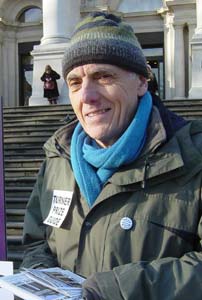 It
is as if, after all those sterile years of Conceptualism, denied the
means to express his undoubtedly sincere preoccupations with death,
Damien Hirst's ideas and feelings are finally pouring out in paint on
canvas. These grinning skulls and bleached jawbones have a quiet and
mysterious presence, as they emerge from the surrounding darkness. They
keep renewing themselves as one looks at them and there is a cumulative
effect as you pass along the line of works. These skulls are not dead
matter like his sharks; they have a spiritual life, with personalities
of a sort, as they hang in space. The painting of flowers and butterflies
is quite beautiful, but is perhaps the least impressive of the works.
It
is as if, after all those sterile years of Conceptualism, denied the
means to express his undoubtedly sincere preoccupations with death,
Damien Hirst's ideas and feelings are finally pouring out in paint on
canvas. These grinning skulls and bleached jawbones have a quiet and
mysterious presence, as they emerge from the surrounding darkness. They
keep renewing themselves as one looks at them and there is a cumulative
effect as you pass along the line of works. These skulls are not dead
matter like his sharks; they have a spiritual life, with personalities
of a sort, as they hang in space. The painting of flowers and butterflies
is quite beautiful, but is perhaps the least impressive of the works.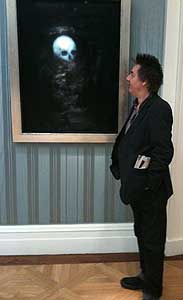
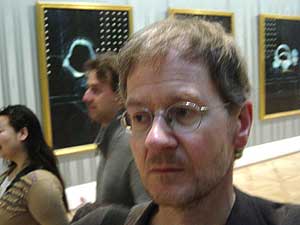
 It
is somewhat surprising and fascinating that Damien Hirst has decided
to pick up a paintbrush again after years of milking the cash cow that
is conceptual art. Incredibly he has managed to use his heart instead
of his wallet and produced a series of (mostly) remarkable works.
It
is somewhat surprising and fascinating that Damien Hirst has decided
to pick up a paintbrush again after years of milking the cash cow that
is conceptual art. Incredibly he has managed to use his heart instead
of his wallet and produced a series of (mostly) remarkable works.
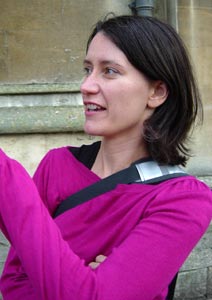 As
for Hirst, yes, I saw a photo of one of his paintings (Requiem, White
Roses and Butterflies) and thought it was quite good. The fact the
critics are dismissing his work is indeed hilarious. What a funny art
world - well, it would be funny if it wasn't such a complete joke.
As
for Hirst, yes, I saw a photo of one of his paintings (Requiem, White
Roses and Butterflies) and thought it was quite good. The fact the
critics are dismissing his work is indeed hilarious. What a funny art
world - well, it would be funny if it wasn't such a complete joke.
 The
new works by Hirst are what paintings should be - they communicate directly
from the artist's heart, his concerns and aesthetic ideals, in a way
that demonstrates not only technical skill but a dramatic use of space,
luminosity and original application of paint.
The
new works by Hirst are what paintings should be - they communicate directly
from the artist's heart, his concerns and aesthetic ideals, in a way
that demonstrates not only technical skill but a dramatic use of space,
luminosity and original application of paint.
 The
use of dots and lines, and the way Damien Hirst positions objects on
the canvas to create space around them has a very strong impact. The
butterflies look beautiful in the last painting, but do not look out
of place amongst images of skulls and darkness. I get the impression
he is trying to communicate very directly, with lines linking objects
together and blackness around objects forcing your attention to where
he wants. I didn't fully appreciate this until my third visit to the
show. On each visit, I got more engrossed in the work. The lack of colour,
and large areas of blackness, are effective. I get a strong feeling
of beauty from his dark paintings.
The
use of dots and lines, and the way Damien Hirst positions objects on
the canvas to create space around them has a very strong impact. The
butterflies look beautiful in the last painting, but do not look out
of place amongst images of skulls and darkness. I get the impression
he is trying to communicate very directly, with lines linking objects
together and blackness around objects forcing your attention to where
he wants. I didn't fully appreciate this until my third visit to the
show. On each visit, I got more engrossed in the work. The lack of colour,
and large areas of blackness, are effective. I get a strong feeling
of beauty from his dark paintings.
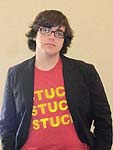 I
never thought in a million years I'd say this, but Damien Hirst is my
new art hero. I must say, I like his new paintings. He's revealed to
the world the fact that he's just a flawed human being like the rest
of us. I think that's a noble quality to have as an artist. It must
have taken him quite a bit of soul-searching to come to that realisation,
and for that I respect and support him. We are bearing witness to a
metamorphosis, the emergence of the real Damien Hirst. The old Hirst
we knew and loathed has died with conceptualism.
I
never thought in a million years I'd say this, but Damien Hirst is my
new art hero. I must say, I like his new paintings. He's revealed to
the world the fact that he's just a flawed human being like the rest
of us. I think that's a noble quality to have as an artist. It must
have taken him quite a bit of soul-searching to come to that realisation,
and for that I respect and support him. We are bearing witness to a
metamorphosis, the emergence of the real Damien Hirst. The old Hirst
we knew and loathed has died with conceptualism.
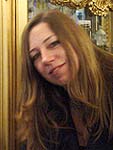 Damo
- what a lad…
Damo
- what a lad…


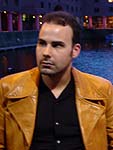 Jesse
Richards
Jesse
Richards
.jpg) The
Wallace Collection paintings (of Hirst) seem to have been universally
critically panned. Though I haven't seen the work in the flesh I am
pretty sure that on the basis of what I have seen online they are not
the worst paintings to have been let loose on the world in recent years
- which is the impression we the punters are being critically fed.
The
Wallace Collection paintings (of Hirst) seem to have been universally
critically panned. Though I haven't seen the work in the flesh I am
pretty sure that on the basis of what I have seen online they are not
the worst paintings to have been let loose on the world in recent years
- which is the impression we the punters are being critically fed.